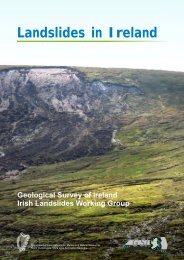Download - Geological Survey of Ireland
Download - Geological Survey of Ireland
Download - Geological Survey of Ireland
You also want an ePaper? Increase the reach of your titles
YUMPU automatically turns print PDFs into web optimized ePapers that Google loves.
Geology Matters - Autumn 2006<br />
DIRECTOR’S DISCOURSE<br />
This issue describes a series <strong>of</strong><br />
airborne geophysical surveys which<br />
were carried out in various parts <strong>of</strong><br />
the country in June 2006. These are<br />
not the first airborne geophysical<br />
surveys to be carried out in <strong>Ireland</strong>. It<br />
is now about a quarter <strong>of</strong> a century<br />
since an extensive airborne magnetic<br />
survey was undertaken over the<br />
Midlands. Although using a single<br />
technique at relatively low resolution,<br />
the results <strong>of</strong> this survey have been<br />
used ever since in mineral exploration<br />
and a variety <strong>of</strong> research projects. In<br />
more recent years, as part <strong>of</strong> the Irish<br />
National Seabed <strong>Survey</strong>, laser-based<br />
bathymetric mapping <strong>of</strong> coastal<br />
waters was completed in a number <strong>of</strong><br />
bays on the west coast<br />
<strong>of</strong> <strong>Ireland</strong> and these<br />
have important<br />
applications in maritime<br />
safety and shipping<br />
development.<br />
The recent airborne<br />
surveys had equally important<br />
applications, being capable <strong>of</strong><br />
mapping out areas with potential for<br />
high indoor radon. They can also<br />
outline the extent <strong>of</strong> important aquifers<br />
and assist in the assessment <strong>of</strong> their<br />
vulnerability to pollution. Applications<br />
in mineral exploration and<br />
infrastructure development are just<br />
additional examples <strong>of</strong> what these<br />
surveys have to <strong>of</strong>fer. They provide<br />
high resolution images <strong>of</strong> the<br />
subsurface on a systematic basis,<br />
regardless <strong>of</strong> whether bedrock<br />
exposures exist or not and regardless<br />
<strong>of</strong> whether the environment is urban<br />
or rural.<br />
...we have become<br />
increasingly aware<br />
that our environment<br />
is not entirely<br />
benign...<br />
GSI is currently examining the<br />
potential relevance <strong>of</strong> such surveys<br />
to a wide range <strong>of</strong> applications<br />
including the monitoring and<br />
assessment <strong>of</strong> natural hazards. While<br />
<strong>Ireland</strong> is blessed with a relatively safe<br />
environment, free <strong>of</strong> catastrophic<br />
earthquakes and volcanoes, we have<br />
become increasingly aware that our<br />
environment is not entirely benign.<br />
The occurrence <strong>of</strong> indoor radon is one<br />
issue which many communities in<br />
recent years have had to face.<br />
Another natural hazard is landslides,<br />
dramatically brought to national<br />
attention a few years ago by events<br />
in Galway and Mayo, and recent<br />
research work suggests that the<br />
national incidence <strong>of</strong><br />
such hazards has been<br />
underestimated.<br />
Airborne surveys may<br />
have a role in such<br />
situations.<br />
It is pleasing to report<br />
that there has been a broad welcome<br />
for the recent airborne surveys from<br />
both local communities and the media.<br />
They can provide important<br />
information on our natural<br />
environment that might otherwise not<br />
be available and the results <strong>of</strong> the<br />
2006 surveys, in due course, will be<br />
important in illustrating this.<br />
Meanwhile GSI aspires to delivering<br />
such benefits on a nationwide basis<br />
and looks forward to receiving<br />
adequate funding to achieve this.<br />
Strategy for<br />
Science,<br />
Technology and<br />
Innovation (2006-<br />
2013)<br />
Barry Mc Sweeney<br />
This strategy was developed by the<br />
Interdepartmental Committee in<br />
response to a request from the<br />
Cabinet Sub Committee on Science,<br />
Technology and Innovation. It follows<br />
on from the National R and D action<br />
plan 2004 and is based on the results<br />
<strong>of</strong> the SWOT analysis <strong>of</strong> <strong>Ireland</strong> as a<br />
knowledge based economy, which<br />
was carried out under the aegis <strong>of</strong> the<br />
<strong>of</strong>fice <strong>of</strong> the Chief Science Adviser in<br />
2005. The Strategy was approved by<br />
Government in June 2006.<br />
Content <strong>of</strong> Document<br />
The broad context, vision and<br />
challenges facing <strong>Ireland</strong> in its attempt<br />
to become a knowledge-based<br />
economy, is presented in the opening<br />
chapter. The details on the<br />
development <strong>of</strong> 4 th level education is<br />
presented in chapter two and is based<br />
on the report <strong>of</strong> the Research Funders<br />
Group on research capacity (2005),<br />
OECD report on HE system (2004)<br />
and other work. The Strategy includes<br />
doubling the number <strong>of</strong> PhD students,<br />
recruitment <strong>of</strong> 350 additional principal<br />
investigators, 1050 additional<br />
researchers and 350 technicians/<br />
research assistants. It provides for<br />
new buildings to house the<br />
researchers and highlights the need<br />
for new methods <strong>of</strong> training graduate<br />
students. It underlines the importance<br />
<strong>of</strong> developing a career structure for<br />
researchers and the need to attract<br />
page 2

















